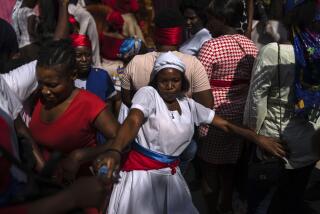West African Drums Have Beat on Media Competition : Communications: Learning to decipher the sound of the ancient instruments is becoming a lost art. But efforts to restore it have begun.
- Share via
ABIDJAN, Ivory Coast — An airplane is a canoe that flies like a bird.
An airplane that crashes in the United States is a canoe that flies like a bird that has fallen out of the sky in the land of the white man behind the ocean.
The ancient talking drums of West Africa, in their own stylized and often allegorical lingo, bring modern news to the people far more quickly and colorfully than the talking heads on television.
Bombarded by modern media, however, fewer young people are able to decipher the sophisticated beats bouncing from village to village.
Georges Niangoran-Bouah, a National Institute of Arts anthropologist and the Ivory Coast’s leading drumologist, is heading a crusade to make “drumspeak” mandatory study in elementary school before the art is lost.
“We are going to teach the drum in the schools,” he said. “We’ve already started at the university.”
The talking drums produce modulated tones that evoke a spoken language and are part of the rich legacy of the Akan people throughout West Africa.
In Ghana, the state radio news always begins with a dramatic cadence of thumps that mean, “Listen up, Ghana!” or, “And now, the news.”
At dawn, hours before people tune into the news on their radios and televisions, villagers already have been filled in about the farm reports, deaths, weddings, births and other news.
The language sometimes does somersaults to reflect modern times. If a Western medical relief group is coming to a village to vaccinate children, the drums announce:
“The white healers will come on the morrow. Gather the children under the banyan tree to keep them well.”
In terms of reach, the drums saturate more markets than cellular phones. A drummer can send his message over a 25-mile radius, where other drummers pick it up and pass it along.
In a couple of hours, a message can be catapulted across the Ivory Coast and through neighboring Ghana, borne along by the numerous tribes that make up the Akan people.
The drummers got one of their longest workouts when President Felix Houphouet-Boigny, who ruled Ivory Coast for 33 years and was an Akan chief, died on Dec. 7.
Niangoran-Bouah was called home from Switzerland, where he was living, to preside over the elaborate drum lexicon during the two-month mourning period.
“The great elephant has lost its teeth,” was the first announcement the drums made.
The beat went on until the president was buried Feb. 7. Each day the drums recounted his deeds with a variety of colorful introductions.
“The leopard has lost his spots. The baobab (tree) has crashed down.”
Only on the day of his funeral did the drums stop beating around the bush: “There is death in the house. There is great sorrow in this house.”
French colonizers and Christian missionaries made periodic attempts to silence the drums, which they considered sacrilegious, sort of a timpani for the devil.
Hundreds of drums were burned, but the language endured.
Niangoran-Bouah believes Ivorians voyaged across the Atlantic to the Americas centuries ago because of an ancient phrase, “The people on the other side of the ocean . . . have plumes on their heads and tails for hair.”
“Who could that be but Indian Americans?” said Niangoran-Bouah, who has written three books on Akan culture and is compiling a talking-drum dictionary.
The drums were silent on one of civilization’s biggest news stories--when Neil Armstrong became the first human to walk on the moon in 1969.
“We didn’t think it was important,” said Niangoran-Bouah.
More to Read
Sign up for Essential California
The most important California stories and recommendations in your inbox every morning.
You may occasionally receive promotional content from the Los Angeles Times.












